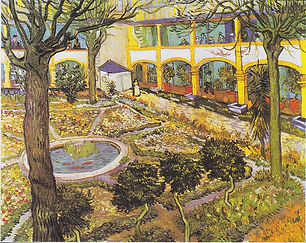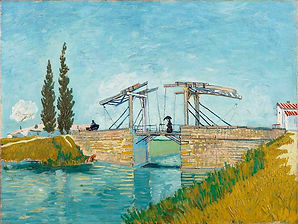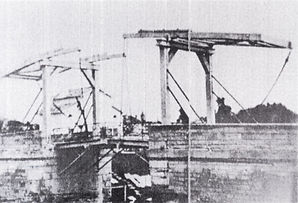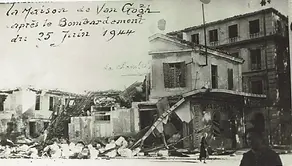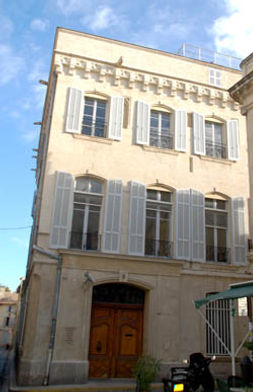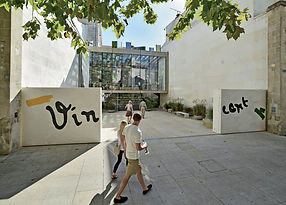Vincent van Gogh

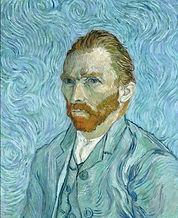
Vincent van Gogh is arguably Arles’ most famous son and the town authorities have spend a considerable amount of time and money over the years trying to leverage that idea into a marketable (and therefore profitable) concept. This is not the place to give a complete account of van Gogh and his apparently agonised time in the town. Thousands of books, journal articles, website pages exist for those who are interested to read a full cross-section of works that range from the scholarly (but not necessarily accurate) to the completely barmy.
A few salient facts are as follows:
· Van Gogh stayed in the town between February 1888 and May 1889 during which time he painted approximately one hundred and eighty paintings.
· He occupied the so-called Yellow House between September 1888 and sometime in March 1989.
· Gauguin stayed with him for only two months between the end of October and the end of December 1888.
· Somehow (various opinions are held) the lower part of his left ear lobe (various opinions exist about how much - never the complete ear) was cut off at the end of December. It may (or may not) have been given to a prostitute for “safe keeping”. It was not sent anywhere by mail as some stories go. It is unlikely that the French postal service was any more reliable then than now and the bloody piece would almost certainly have been lost or delivered a year later to Marseille or London or New York.
· He was forced to leave the Yellow House after a petition from Arles townspeople who finally tired of his eccentricities.
· He was hospitalised in Arles from time to time, stayed with his local doctor until he entered the mental hospital in St Remy de Provence in May 1989.
· There are no paintings by Van Gogh in Arles.
· There are some drawings by Van Gogh in the Reattu.
The “spot the location of Van Gogh’s pictures around Arles ” has developed into an honourable tradition over the years but for those who have a limited time in the town, the city has provided a Van Gogh Tour marked by faded ceramic tiles set into the pavement at various locations around the town. This wonderfully eccentric guide is almost completely useless. However, the city has also provided large ceramic reproductions of some of his best known works at locations which allow you to compare what van Gogh painted with what you can see now. What one should learn from this slightly idiosyncratic comparison has always escaped me. The relationship between what was there to start with, what Van Gogh saw and what he actually painted is complicated enough without factoring in the century of change that has followed. However there are a number of popular locations for tourists to snap “me and the ceramic reproduction of the Starry Night standing in front of the scene that now hardly resembles what van Gogh saw” pictures.
More interesting for those of a slightly philosophical mind (and ex-art historians like me) are the locations around the town where the old “does art have to imitate life?” question is turned on its head and life is made to imitate Van Gogh. A few of them are:
The Hôtel de Dieu
The Hotel de Dieu was Arles main hospital constructed in the 16th and 17th centuries. The fine, five - storied, quadrangular building famously played host, very briefly, to Van Gogh during one of his more difficult medical moments - but probably not immediately after the ear cutting episode which is almost certainly a nice amalgamation of two stories for marketing purposes. He did however paint his famous Jardin de l'Hôpital en Arles which shows the formal set out of the square garden. This garden and the building that surrounds it are planted and cultivates each year so that they resemble the painting with fervent accuracy. Just in case you miss the connection, the entire building that now contains the town library, various academic and administrative offices and exhibition spaces has been renamed L’Espace Van Gogh for good measure. Of course, the scene has been enhanced by an oversize ceramic reproduction of the painting in question.
The Langlois Bridge
At least ten versions of Van Gogh’s famous painting of this bridge exist and you can visit the bridge at its present location some five kilometres south of the town on the road to Mas Thibert and Salin-de-Giraud. It is a good half hours stiff walk from the Arena. There is a bus. Some busses on the No.1 line (Trebon / Barriol) go (near) there but check the timetable if you want to get back the same day! Unfortunately, the original bridge was originally located further down the canal between Arles and Port de Bouc. It is uncertain where exactly was the bridge that was van Gogh’s subject because a series of eleven identical bridges had been built to span the canal and Van Gogh was never completely reliable when it came to recording local topography. They all fell into disrepair and were replaced by more prosaically concrete ones as the canal was no longer used. This last wooden one was “reconstructed” nearer the town for the sake of the tourists in 1962 and, of course, christened Le Pont Van Gogh. Langlois was actually the name of the bridge’s keeper not the place it stands. Van Gogh himself called the bridge Le Pont de l’Anglais, presumably misunderstanding the man’s name.
Café Terrace
If you do like life imitating art then I can do no better than to recommend an eye-wateringly expensive coffee (or more for dreadful food if you have a gold card) at the so-called Café de la Nuit on the Place du Forum. Please note that this is definitely not a gastronomic recommendation. This café, immortalised in Van Gogh’s painting Café Terrace of 1889, is repainted almost every year in order to try to make it look more and more like the original, nocturnal, gas-lit muck yellow building of the famous picture. It might be noted that the yellow was the gas light not the building which was, in fact, white. Whether or not this operation is a success in a matter of personal opinion but they certainly have succeeded in making the café look during the daytime as if someone has been sick all over it. (The immediately neighbouring Café Tambourin is a much better and less extravagant place to take a coffee or a Pastis. DO NOT EAT on the Place du Forum.
The Yellow House
In the summer of 1944, the American air force decided to preface their army’s occupation of the South of France with series of bombing raids, ostensibly to destroy the railway bridges across the Rhône and various other strategic targets. One of their targets was the rail bridge in Arles between the present bus and train station and Tranquetaille across the river. It was considered to be a prime route for potential German troop withdrawals from the territory to the west of the river. Owing to their propensity for bombing from high altitude in spite of the fact that Arles has no anti-aircraft defences, (few Germans either by that time) the bombing was less than precise and cut a great swathe through Arles in a north-north east direction starting south east of the Place de la Major (and Smith's house), taking in a side of the Arena and finishing in Tranquetaille across the river thus reducing a major part of an erstwhile beautiful town to rubble, for reasons that still mystify slightly. There is a scurrilous rumour in the town’s folk law that the Americans were actually intending to bomb the much more important rail crossing at Avignon and made a mistake having seen a river and a bridge from a great height. To be fair, given that Avignon was liberated exactly a month later after similarly intensive bombing this would seem to be unlikely. But ...
They “got” the bridge finally after numerous attempts - although it is difficult to see the strategic value of the single track line that went only to Stes. Maries de la Mer on the Camargue and Nîmes, a direction very different from that in which the occupying Germans were already withdrawing. They also “got” Van Gogh’s famous little Yellow House on the north side of what is now the Place Lamartine. It exists only as dust and memories.
The van Gogh Foundation
Oh dear. This used to housed in a thoroughly pseudo Italianate but nevertheless imposing building (the so-called Palais Luppé) to the west of the Amphitheatre. However it is now relocated (courtesy of our own local pharmaceutical billionairess) to the old Banque de France building on the Rue du Docteur Fanton. The ancient and faintly fortified facade of 15th century Hôtel Léautaud de Donines has been torn off in an act of institutional vandalism and replaced by a huge plate glass window that make the place look like an airport lavatory. Nevertheless it houses the utterly misnamed Fondation van Gogh de la Ville d’Arles.
There is a substantial charge to get in (€108 or more when there is a special show) so I have no reservations about telling you that you NOT usually find any van Gogh works inside. There were a few (including the Yellow House) for the opening exhibition that finished on 31st August 2014. As mentioned before in this guide, there are none normally resident in Arles. What you will find (when other contemporary art shows are not taking up the wall space) is a collection of works “inspired by van Gogh”. The collection is pretty mediocre – dreadful, is a better word, in my view – and should only be visited by people who might be interested in seeing arguably the worst Francis ever painted. Visit only if it is raining and you are desperate for something to do. Recent information is that the Bacon might be reclaimed by those in the UK who wish to own these things. This will be a relief and ironically might improve the collection by leaving it. What is going to befall the Palais Luppé remains to be seen.
The Foundation’s activities remain a mystery and, apart from a rather poignant opening exhibition when a few paintings by the master were allowed temporarily to return to the city of their birth, it continues to house art “inspired” by the memory of van Gogh. Judging by what is exhibited, that memory is fading faster that the passage on time since the artist’s death might suggest.
